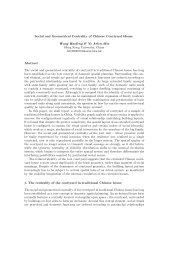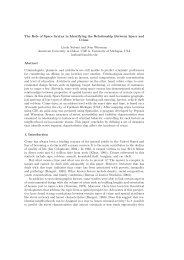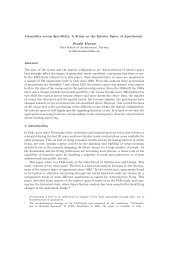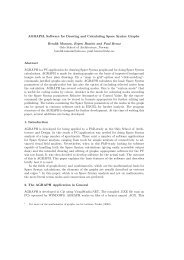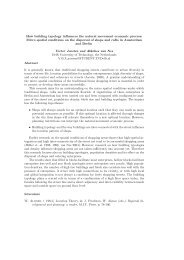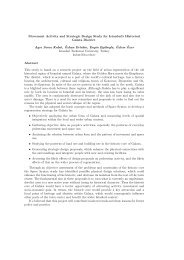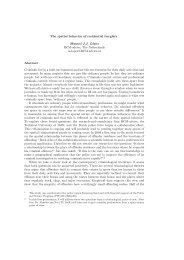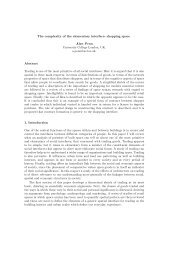High Resolution Analysis of Crime Patterns in Urban Street Networks
High Resolution Analysis of Crime Patterns in Urban Street Networks
High Resolution Analysis of Crime Patterns in Urban Street Networks
You also want an ePaper? Increase the reach of your titles
YUMPU automatically turns print PDFs into web optimized ePapers that Google loves.
<strong>High</strong> <strong>Resolution</strong> <strong>Analysis</strong> <strong>of</strong> <strong>Crime</strong> <strong>Patterns</strong> <strong>in</strong> <strong>Urban</strong> <strong>Street</strong> <strong>Networks</strong>: an <strong>in</strong>itialstatistical sketch from an ongo<strong>in</strong>g study <strong>of</strong> a London borough 461<strong>in</strong> segments which are less connected, but significantly longer than those without, and alsoon l<strong>in</strong>es which are both significantly longer and more connected hen those without, andsignificantly more <strong>in</strong>tegrated locally and globally. Compar<strong>in</strong>g the two crimes, we can saythat robbery is a significantly more <strong>in</strong>tegrated crime than burglary, and this is alreadyclear from Figures 219 and 220.7. Disaggregated analysis: the concept <strong>of</strong> primary risk bandsOur aim here, however, is to relate the pattern <strong>of</strong> crime to the micro properties <strong>of</strong> the streetnetwork, and to do this we must establish a unit <strong>of</strong> analysis and a rate. In previous studies<strong>of</strong> burglary (Hillier and Shu 2000) and robbery (Alford 1996), the unit <strong>of</strong> analysis has beenthe l<strong>in</strong>e. This is a rather gross element, which can differ quite considerably <strong>in</strong> spatial andfunctional properties along its length, so a more micro-scale element would be better. Forburglary, previous syntactic studies have also used the s<strong>in</strong>gle dwell<strong>in</strong>g as the unit, withspatial differences <strong>of</strong> the street segment on which it lies assigned to the dwell<strong>in</strong>g. Thispermitted the use <strong>of</strong> logistic regression to establish the burglary risk associated with eachvariable. However, for our present purposes, there is no robbery equivalent to this becausethe target is an <strong>in</strong>dividual rather than a build<strong>in</strong>g, and we cannot compare robbed andunrobbed people <strong>in</strong> the same way that we can compare burgled and unburgled dwell<strong>in</strong>gs.The obvious micro unit <strong>of</strong> analysis is the street segment, which is already the basic unit<strong>of</strong> the spatial analysis <strong>of</strong> the street network. But this would only be mean<strong>in</strong>gful if we couldestablish a rate for each crime for a segment, and this is highly problematical. For burglary,for example, however we def<strong>in</strong>e a unit <strong>of</strong> analysis above the level <strong>of</strong> the <strong>in</strong>dividual house- the segment, the street, the block, the adm<strong>in</strong>istrative area, the geometrically def<strong>in</strong>edquadrant, and so on - then a primary factor <strong>in</strong>fluenc<strong>in</strong>g the number <strong>of</strong> burglaries with<strong>in</strong>that unit will be the number <strong>of</strong> residences, or targets, with<strong>in</strong> the unit. This can be shown byconsider<strong>in</strong>g a random pattern. If there is a random pattern <strong>of</strong> burglary - say by assign<strong>in</strong>geach house a random number and us<strong>in</strong>g a random number selector to select ‘burgled’houses - then as the number <strong>of</strong> burglaries <strong>in</strong>creases there will be more <strong>in</strong> units with moreresidences. So <strong>in</strong> terms <strong>of</strong> absolute numbers it will appear that there are ‘more’ burglaries<strong>in</strong> units with more residences. If we then try to correct this by express<strong>in</strong>g burglary as arate divid<strong>in</strong>g the number <strong>of</strong> burglaries by the number <strong>of</strong> residences, then <strong>in</strong> the early stages<strong>of</strong> the process, and perhaps for much <strong>of</strong> the process, then units with more residences willappear to have lower rates, because the number <strong>of</strong> residences is now the denom<strong>in</strong>ator, andso each randomly assigned ’burglary’ will contribute less to the ‘rate’, and it will appearthat units with more residences have lower rates. We can show this graphically by simplyplott<strong>in</strong>g the count <strong>of</strong> burglaries per segment aga<strong>in</strong>st the rate (number <strong>of</strong> burglaries overnumber <strong>of</strong> residences) for all street segments <strong>in</strong> the Borough (Figure 223).We see that all the highest count segments have relatively low rates and all <strong>of</strong> thehighest rate segments have relatively low counts. We cannot then use either mean<strong>in</strong>gfullyfor statistical analysis. But if we try to standardise the number <strong>of</strong> residential units, as <strong>in</strong>the Output Areas <strong>of</strong> the 2001 Census for example, then we can only do so by sacrific<strong>in</strong>gconsistency <strong>in</strong> the spatial descriptors <strong>of</strong> our unit. Output areas <strong>of</strong>ten comb<strong>in</strong>e dwell<strong>in</strong>gsfrom ma<strong>in</strong> streets, a back street, and maybe also a cul-de-sac, so the spatial coherence <strong>of</strong>the unit is lost.However, we can escape this problem by aggregat<strong>in</strong>g all segments with a given number<strong>of</strong> residential units, or with<strong>in</strong> a certa<strong>in</strong> band <strong>of</strong> residential units, and calculat<strong>in</strong>g a burglary



